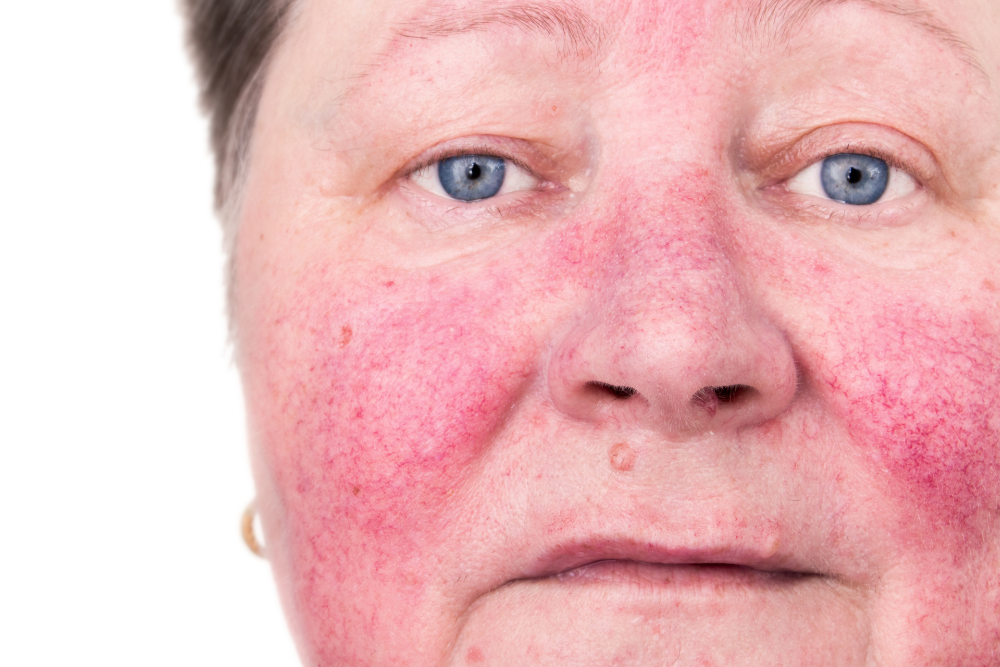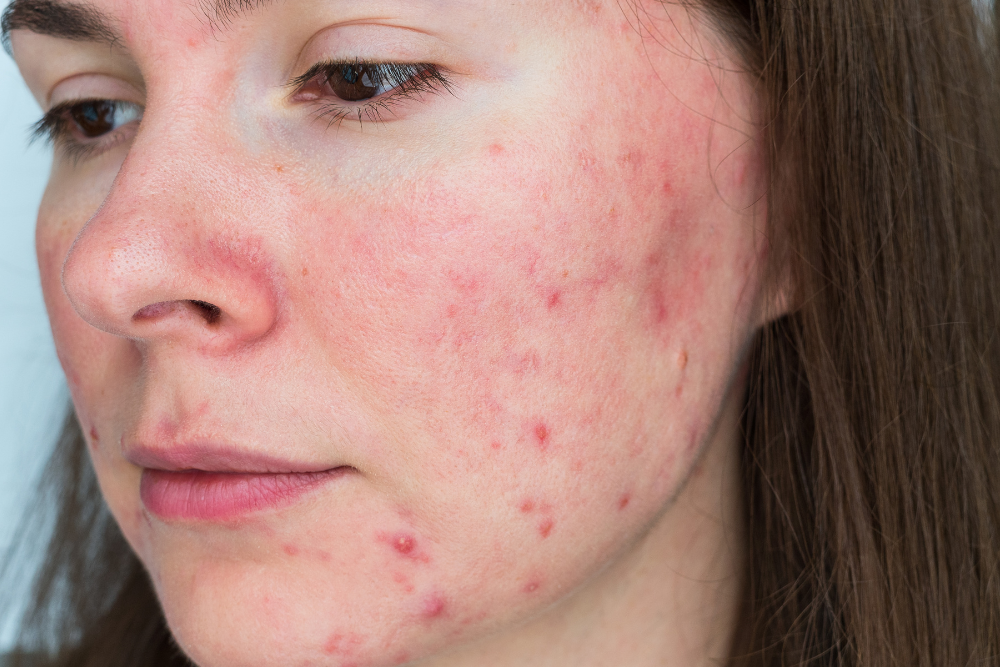Lupus rash and rosacea are both skin conditions that can cause visible redness and discomfort, but they arise from different underlying causes. Understanding the differences between these conditions is helpful towards gaining an accurate diagnosis and effective treatment. So, let’s dive into the key differences between lupus rash and rosacea, exploring their symptoms, diagnosis, treatment options, and more.
Understanding Lupus Rash
Lupus is a long-term autoimmune disease where the body’s immune system mistakenly attacks healthy tissues. It can impact various parts of the body, leading to inflammation and damage (1).
There are several forms of lupus, including:
- Systemic lupus erythematosus (SLE): This is the most common type, potentially affecting multiple organs such as the skin, joints, heart, lungs, kidneys, or brain (1).
- Discoid lupus: Primarily affects the skin, causing rashes and lesions, and is typically less severe than SLE (1).
- Subacute cutaneous lupus: Generally causes milder symptoms like rashes and joint pain (1).
- Drug-induced lupus: Caused by certain medications, it usually resolves once the triggering drug is stopped (1).
- Neonatal lupus: This rare form occurs when lupus-related antibodies are passed from the mother to the baby during pregnancy, leading to temporary issues such as rashes or liver problems. Most symptoms fade within 6 to 12 months after birth (1).
Lupus symptoms vary in severity, with most individuals experiencing mild forms of the disease. It predominantly affects women, with onset typically occurring between the ages of 15 and 45 (1).
Symptoms of Lupus Rash
Lupus presents differently in each individual, with symptoms that can vary over time. Symptoms may be vague or subtle, but during a flare, they often intensify (1).
The condition is unpredictable—some people may experience mild symptoms after an initial flare, while others may go through cycles of remission, alternating with flare-ups of more severe symptoms (1).
Common symptoms of lupus include:
- Joint pain, stiffness, or swelling, particularly in the hands and feet (1).
- Rashes that worsen with sun exposure (1).
- Fever (1).
- Fatigue, weakness, and a general feeling of malaise (1).
- Unexplained weight loss (1).
Skin manifestations vary widely, with some people developing the classic butterfly-shaped rash across the cheeks. Others may notice red patches on sun-exposed skin, which can appear ring-like. In discoid lupus, these patches may lead to scarring or skin discolouration (1).
Additional symptoms can include:
- Hair loss or thinning (1).
- Muscle aches (1).
- Headaches (1).
- Mouth ulcers (1).
- Abdominal pain (1).
- Raynaud’s phenomenon, where extremities change colour in response to cold or stress (1).

Understanding Rosacea
Rosacea is a chronic skin condition characterised by facial redness, visible blood vessels, and sometimes, small, red, pus-filled bumps (2). While the exact cause of rosacea remains unknown, factors such as genetics, environmental triggers, and vascular abnormalities are believed to contribute to its development (2).
Symptoms of Rosacea
Symptoms of rosacea may include:
- Facial Redness: Persistent flushing or redness, particularly in the central face (2).
- Visible Blood Vessels: Small, visible blood vessels (telangiectasia) on the cheeks, nose, and forehead (2).
- Papules and Pustules: Bumps or pimples on the face that may burn or sting (2).
In some cases, rosacea can also affect the eyes, leading to symptoms such as redness, soreness, and grittiness (2). Skin may also thicken, especially around the nose (2).

Differentiating Lupus Rash from Rosacea
While lupus rash and rosacea can both cause facial redness and skin irritation, several key differences can help distinguish between the two conditions:
Underlying Cause
Lupus is an autoimmune disease where the immune system mistakenly produces antibodies that attack the body’s own tissues, resulting in inflammation, pain, and damage to various organs. The causes of lupus are not fully understood but are believed to involve a combination of genetic, hormonal, and environmental factors. Common triggers for lupus flares include excessive sunlight exposure, certain medications, infections, and stress. Unlike rosacea, lupus can affect multiple body systems, leading to a wider array of symptoms beyond just skin manifestations (1).
In contrast, rosacea is primarily characterised by skin-related symptoms that may be influenced by genetic predisposition, environmental factors, and a reaction to the Demodex mite, a microscopic organism found on the skin. Common triggers for rosacea symptoms include weather conditions (like sunlight and temperature extremes), dietary factors (such as alcohol and spicy foods), and emotional responses (like stress and embarrassment). These triggers can lead to flare-ups of redness and irritation in the facial skin (2).
Associated Symptoms
Lupus presents a wide array of symptoms that can vary significantly from person to person and may change over time. Individuals often experience vague symptoms that can become more pronounced during a flare. Some people may have few symptoms after their initial flare, while others alternate between periods of remission and subsequent flare-ups. Common symptoms of lupus include:
- Joint pain, stiffness, or swelling, particularly in the hands and feet.
- Skin rashes that often worsen with sun exposure.
- Fever and persistent fatigue.
- Unexplained weight loss.
- The appearance of different skin rashes, including the butterfly rash, characterised by a red or purple rash across the cheeks, and discoid lesions, which may cause scarring or discoloration.
Other possible symptoms can include hair loss, muscle aches, headaches, mouth ulcers, abdominal pain, and Raynaud’s phenomenon, where extremities change colour in response to temperature changes (1).
In contrast, rosacea is primarily a skin condition characterised by facial redness and irritation. Symptoms of rosacea may include:
- Frequent blushing or flushing, particularly on the cheeks, nose, chin, or forehead.
- Persistent redness resembling sunburn that does not subside.
- Visible small blood vessels on the face.
- Bumps or pimples that may sting or burn, mainly affecting the cheeks, chin, and nose.
- Thicker skin, especially around the nose, which may appear swollen.
- Red, sore, or gritty eyelids.
Facial redness is the hallmark of rosacea and may become more persistent over time (2).
In summary, while both lupus and rosacea can exhibit skin-related symptoms, lupus is associated with a broader range of systemic symptoms affecting various body systems, whereas rosacea is primarily characterised by persistent facial redness and localised skin issues.
Differences in Treatments for Lupus and Rosacea
The management of lupus and rosacea reflects their distinct natures and symptomatology.
Lupus is a chronic autoimmune disease that requires individualised treatment strategies based on the severity of the condition and the organs involved. While there is no cure, most individuals can manage their symptoms effectively and maintain a good quality of life through a combination of medications and lifestyle changes. Treatment options for lupus may include:
- Medications: Non-steroidal anti-inflammatory drugs (NSAIDs) for joint and muscle pain, a medication originally used to treat malaria for joint pain, skin rashes, and fatigue, corticosteroids for serious complications, and other immune system-modulating drugs.
- Lifestyle Measures: Strategies such as getting adequate rest, managing stress, engaging in regular moderate exercise, maintaining a healthy diet, quitting smoking, moderating alcohol intake, and protecting the skin from sun exposure play vital roles in managing lupus symptoms (1).
In contrast, rosacea is primarily a skin condition with no known cure, but several treatment options can help alleviate symptoms. Management strategies for rosacea typically include:
- General Measures: Identifying and avoiding personal triggers, using non-irritating and oil-free skin-care products, applying sunscreen, keeping the face cool to reduce flushing, and avoiding corticosteroid creams, which can worsen the condition.
- Medications: Treatments for rosacea may include topical agents like cream or gel and azelaic acid, as well as oral medications such as antibiotics to reduce inflammation. Additionally, laser therapy can be used to address visible blood vessels or significant redness, although multiple sessions may be necessary (2).
In summary, while both lupus and rosacea require ongoing management, lupus treatment focuses on controlling systemic symptoms through medication and lifestyle modifications, whereas rosacea treatment emphasises topical and oral medications along with avoidance of triggers to manage skin-specific symptoms.

How is Lupus Diagnosed?
Diagnosing lupus primarily involves a thorough discussion between you and your doctor, along with a physical examination. Your doctor will inquire about your symptoms and may recommend various blood tests. One of the key tests is the anti-nuclear antibody (ANA) test, which determines the presence of antibodies that target your own cells. In addition, you might undergo a urine test, a chest X-ray, and evaluations to assess your heart function. In some cases, a biopsy may be necessary.
It’s important to note that there isn’t a single definitive test for lupus, and establishing a diagnosis can sometimes take time, as it may not be immediately apparent.
How is Rosacea Diagnosed?
The diagnosis of rosacea typically begins with your doctor reviewing your medical history and examining your facial skin for characteristic signs. Key indicators of rosacea include:
- A red or flushed appearance on the face
- The presence of papules and pustules (small bumps)
- Visible broken blood vessels
Based on these observations, your doctor can determine whether you have rosacea and discuss potential treatment options.

Prevention Measures for Lupus Rash
While there is no surefire way to prevent lupus rash, adopting certain lifestyle measures may help reduce the risk of flare-ups and minimise symptoms:
- Sun Protection: Sun exposure can trigger lupus rash flare-ups, so wearing protective clothing and sunscreen is essential.
- Stress Management: Stress can worsen autoimmune symptoms, so practising stress-reduction techniques such as mindfulness, yoga, or meditation may be beneficial.
- Regular Monitoring: Regular follow-up appointments with a healthcare provider can help monitor disease activity and adjust treatment as needed.
Early detection and prompt treatment of lupus rash can help prevent complications and improve outcomes.
Seeking Professional Help: When to Consult a Dermatologist
If you experience persistent facial redness, skin irritation, or other concerning symptoms, it’s essential to seek professional medical advice. A dermatologist can provide a comprehensive evaluation, diagnose underlying skin conditions, and recommend appropriate treatment options tailored to your needs.
If you’re experiencing persistent skin symptoms such as facial redness or irritation, don’t wait—schedule a consultation with hub.health to get the answers and support you need for optimal skin health.
Sources
- Healthdirect Australia. Lupus. Available from: https://www.healthdirect.gov.au/lupus
- Healthdirect Australia. Rosacea. Available from: https://www.healthdirect.gov.au/rosacea





